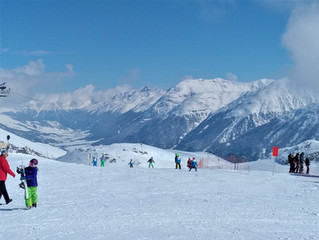St. Moritz: Birthplace of Winter Tourism
- Athena Lucero

- Jan 27, 2020
- 4 min read
Updated: Dec 7, 2020

On the summit of Corviglia Mountain overlooking the Swiss village of St. Moritz, I’m greeted with the bluest of skies, a smiling sun and a treeless snowy landscape as smooth as a white carpet. The thought of skiing the slopes of the world’s first winter resort is nothing short of a dream. Standing 8,156 feet above sea level overlooking snow-covered peaks makes me feel on top of the world.
The sun I speak of when I exit the funicular is the logo of St. Moritz, a registered trademark since 1937. In 1986 “St. Moritz” was added to the logo making it the first geographical location on the planet to own a trademark.
Then I learn the backstory to St. Moritz – long before it became a discreet winter hotspot for royals, the well-to-do and celebs from Charlie Chaplain, Audrey Hepburn, Alfred Hitchcock and Brigette Bardot, to the Kennedy family, Robert De Niro, and Kate Moss.
With over 300 days of sunshine each year St. Moritz, tucked into the Upper Engadin Valley high in the eastern Alps near the Italian border, began attracting wealthy British visitors during spring, summer and fall.
But in 1864, Johannes Badrutt, owner of a 12-room mountain inn called the Kulm, made his famous bet with skeptical British guests to return the following winter. If they weren’t happy, he would pay all their travel expenses. If they liked it, they could stay for as long as they wished. They came that winter – and stayed until spring.
Word spread about St. Moritz and more families escaped Britain’s bleak weather launching the opening of the first tourist office in Switzerland and the start of winter tourism in the Alps.
The Kulm expanded, installed the country’s first electric lighting in 1878 and the first telephone in canton Graubunden in 1889. By 1896 the first electric tram ascended the Alps.

St. Moritz’s “champagne climate” inspired innovative British guests to invent outdoor recreation at the Kulm giving birth to the Cresta Run (a skeleton racetrack built from scratch each year) and bobsledding (called tobogganing in the UK). Soon, the formation of the St. Moritz Tobogganing Club and Cresta Club, still active today, brought intramural sports – and competition -- to the Kulm.
The developments were transformational.
By 1880 St. Moritz hosted Europe’s first curling tournament, and in 1882 the first ice skating championship followed by the first bob race and first golf tournament in the Alps. Switzerland’s first ski school opened. Two Winter Olympic Games (1928 and 1948) and five Alpine Ski World Championships took place here. Then came Europe’s first Snowboard World Cup in 1987 and the first Polo World Cup in the Alps in 1989.

And on a tour of the legendary Kulm, local history comes to life. Franziska Glunz, public relations manager at the hotel, leads me down a corridor into Badrutt’s original 12-room inn that’s been brilliantly preserved. Dim lighting, low ceilings and creaky floors swoop me back in time.
Original signage remains on the door to the living room that is now an executive office. And when Glunz notices me examining the size of the doors, she explains that “…People were smaller back then.”

We return to the Kulm’s present-day lobby seamlessly attached to the ancient inn. Amid Grecian columns and alpine chic décor, rustic roots are remembered. I feel the warmth of a grand living room when I see Badrutt’s portrait hanging on a wall, and a young boy warming up by a crackling fire.
The hallway off the lobby honors the winter sports legacy of the Kulm with vintage photos of early guests at the top of the Cresta Run and a jaw-dropping collection of trophies and memorabilia befitting a museum.
I discover more winter sports history at the Kulm Country Club just a few minutes’ walk from the hotel. A restoration project resurrected the abandoned 1905 Kulm EisPavillon (ice rink). Locals and visitors now enjoy the restaurant/winter sports museum/public gathering spot that reopened for the 2017 World Ski Championship.

The Kulm’s guests of yesteryear would hunger for the gastronomic adventures under its roof: The Pizzeria, The Bob, Grand Restaurant, Chesa al Parc, Kulm Country Club, and two winter pop-ups -- Peruvian cuisine at Sunny Bar by Claudia Canessa said to be the oldest bar in the Alps, and Asian-influences at Michelin-starred The K by Tim Raue.
At the foot of the Piz Bernina, the highest mountain range in the eastern Alps (13,284 feet above sea level), the spectacular landscapes here are Mother Nature’s gifts. And when I realize that I’ve never stood on a frozen lake before, I ask the concierge to point me in the direction of the lake. On my way down through the village, I drool at window displays at glitzy Prada, art galleries, and Conditorei Hanselmann café and confectionary that dates back to 1894.
A steep escalator takes me down to the legendary lake. As pristine as a snow-blanketed field, it’s mind-boggling to think that each winter horse racing, polo and cricket competitions take place right here.

I walk gingerly towards the middle of the lake and turn to look up the hill. There, overlooking the sun-kissed valley, is the ever-present Kulm.

It’s magical here.
Then, I recall my ski day on the Corviglia when I shared the Kulm’s ski shuttle with a friendly Austrian mother and her two young children who come to St. Moritz every winter. I asked the kids if they like skiing.
Big brother, then little sister, grinned from ear to ear.
IF YOU GO:
For more information, visit www.stmoritz.com
My accommodation: The Kulm Hotel St. Moritz, www.kulm.com. Children 12 years and younger enjoy free ski and snow board lessons.
Published version: https://www.creators.com/read/travel-and-adventure/01/20/st-moritz-birthplace-of-winter-tourism
VIDEOS
PHOTO GALLERIES
GALLERY 1 (20 images)
GALLERY 2 (15 images)












































































Comments